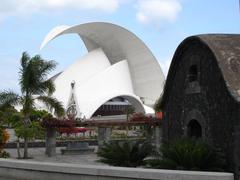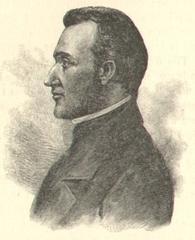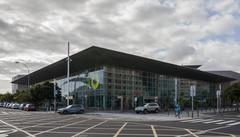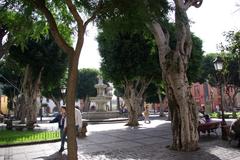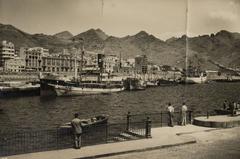Visiting Castillo de San Juan Bautista: History, Tickets, and Visitor Tips
Publication Date: 17/08/2024
Why Visit Castillo de San Juan Bautista?
Castillo de San Juan Bautista, also known as the Black Castle or Castillo Negro, stands as one of Santa Cruz de Tenerife’s most significant historical landmarks. Constructed in the mid-17th century, this iconic fortress has protected the island for centuries, serving as a symbol of its resilience and heritage. From its origins in the plans of Italian military engineer Leonardo Torriani in 1587 to its pivotal role in defending against Admiral Horatio Nelson in 1797, the castle offers a fascinating window into Tenerife’s past (Gobierno de Canarias, Wikipedia). Today, it hosts a museum, cultural events, and reenactments, making it a must-see for both history enthusiasts and casual travelers (Hello Canary Islands, Santa Cruz de Tenerife).
Contents
- Introduction
- History of Castillo de San Juan Bautista
- Visitor Information
- Special Events and Guided Tours
- Photography Tips
- FAQ
- Conclusion
- Sources and Further Reading
Introduction
The Castillo de San Juan Bautista is an enduring monument to the military and cultural history of Santa Cruz de Tenerife. With its unique circular design and prominent coastal location, it has witnessed the island’s evolution from a strategic outpost to a vibrant modern city. This guide provides everything you need to know for an enriching visit, including history, practical visitor information, and recommendations for making the most of your time at the castle.
History of Castillo de San Juan Bautista
Early Conception and Construction
The initial concept for Castillo de San Juan Bautista was put forward in 1587 by Leonardo Torriani, an Italian engineer tasked with strengthening Tenerife’s coastal defenses. He envisioned three fortresses to secure the city, with the Black Castle ultimately being constructed at Caleta de Negros. Construction began in 1641, overseen by Captain General Luis Fernández de Córdoba y Arce, and was completed in 1644. Local citizens played a vital role in funding the project, driven by concerns over political instability in the region (Gobierno de Canarias, Wikipedia).
Architectural Features
The castle is renowned for its robust and innovative circular design, which allowed defenders to cover all angles against potential attacks. Built from black volcanic stone, it earned the nickname “Castillo Negro.” Major renovations in 1765 included the addition of a cylindrical tower facing the sea, enhancing its defensive capabilities and offering a commanding view of the coastline (Hello Canary Islands, Wikipedia).
Role in Defense
Castillo de San Juan Bautista was the second most important fortress in Santa Cruz’s coastal defense system, after Castillo de San Cristóbal. Its strategic position enabled it to guard the approach to the city effectively. The most notable moment in its military history came on July 25, 1797, when it played a decisive role in repelling the British naval assault led by Admiral Horatio Nelson. This victory is celebrated annually and remains a point of local pride (Santa Cruz de Tenerife, Wikipedia).
Decline and Restoration
By the early 20th century, the fortress had lost its military relevance. In 1924, it was decommissioned and later converted into a military museum in 1948. In 1982, the local council took over its management, and in 1993, it was declared a Bien de Interés Cultural (Asset of Cultural Interest), ensuring its preservation as a historical and educational site (Visit Canary Islands, Wikipedia).
Modern-Day Significance
Today, the castle is one of the best-preserved fortifications in the Canary Islands. It serves as a museum, event venue, and educational resource, hosting reenactments and programs that bring its history to life. Its proximity to modern landmarks, such as the Auditorio de Tenerife and Parque Marítimo César Manrique, makes it a convenient and compelling destination for visitors (Santa Cruz de Tenerife).
Visitor Information
Hours and Admission
- Opening Hours: 10:00 AM to 6:00 PM, Tuesday through Sunday. Closed on Mondays and major public holidays.
- Admission: Entry is generally free, though donations are encouraged to support maintenance. Special events or guided tours may have separate fees.
How to Get There
- Location: Avenida Constitución, Santa Cruz de Tenerife, Spain.
- By Foot: Approximately a 10-minute walk from Plaza España.
- Public Transport: Accessible via local bus routes, including 910 and 945 (Lonely Planet).
- Parking: Paid parking is available nearby.
Accessibility
The castle is partially accessible to wheelchair users, with ramps and accessible routes to key areas. Some historic sections may have steps or uneven surfaces. For specific accessibility needs, contact the site in advance.
Nearby Attractions
- Auditorio de Tenerife: A striking modern concert hall by Santiago Calatrava, a short walk away.
- Parque Marítimo César Manrique: A popular waterfront park with swimming pools and gardens.
- Tenerife Espacio de las Artes (TEA): Contemporary art museum within easy reach.
- Mercado de Nuestra Señora de África: Vibrant local market known for fresh produce and Canarian specialties (Lonely Planet).
Special Events and Guided Tours
- Annual Reenactments: The Battle of Santa Cruz de Tenerife is reenacted every July 25, commemorating the island’s historic victory over Nelson’s fleet.
- Guided Tours: Available in several languages, usually at 11:00 AM and 3:00 PM. Advance booking is recommended during busy periods.
Photography Tips
For the best photos, visit during the golden hours (early morning or late afternoon) for soft lighting. Top vantage points include the cylindrical tower, offering panoramic views of the coastline and city. The volcanic stone walls and dramatic setting provide striking backgrounds for memorable shots.
FAQ
What are Castillo de San Juan Bautista’s visiting hours?
10:00 AM to 6:00 PM, Tuesday through Sunday; closed Mondays and on major public holidays.
Is admission free?
Yes, general admission is free, though donations are welcome.
Are guided tours available?
Yes, in multiple languages. Check with the site for times and availability.
Is the castle accessible to visitors with disabilities?
Most main areas are accessible, but some sections have steps or uneven terrain.
Are there dining options nearby?
Yes, Santa Cruz boasts a variety of restaurants and cafes, including local markets where you can sample Canarian cuisine.
Conclusion
Castillo de San Juan Bautista is more than a fortress—it’s a living testament to Santa Cruz de Tenerife’s history and resilience. Its architectural uniqueness, storied past, and vibrant present as a cultural venue make it an essential stop for any visitor. By respecting the site and supporting its preservation, you contribute to safeguarding Tenerife’s heritage for future generations. Plan your visit to include nearby attractions and immerse yourself in the island’s captivating history.
Sources and Further Reading
- Gobierno de Canarias. (n.d.). Castillo de San Juan Bautista. (source)
- Wikipedia. (n.d.). Castillo de San Juan (Santa Cruz de Tenerife). (source)
- Hello Canary Islands. (n.d.). Castillo de San Juan Bautista (Castillo Negro). (source)
- Santa Cruz de Tenerife. (n.d.). Castillos: Castillo de San Juan Bautista. (source)
- Visit Canary Islands. (n.d.). San Juan Bautista Castle. (source)
- Wikipedia. (n.d.). Castle of St John the Baptist. (source)
- Lonely Planet. (n.d.). Castillo de San Juan. (source)
